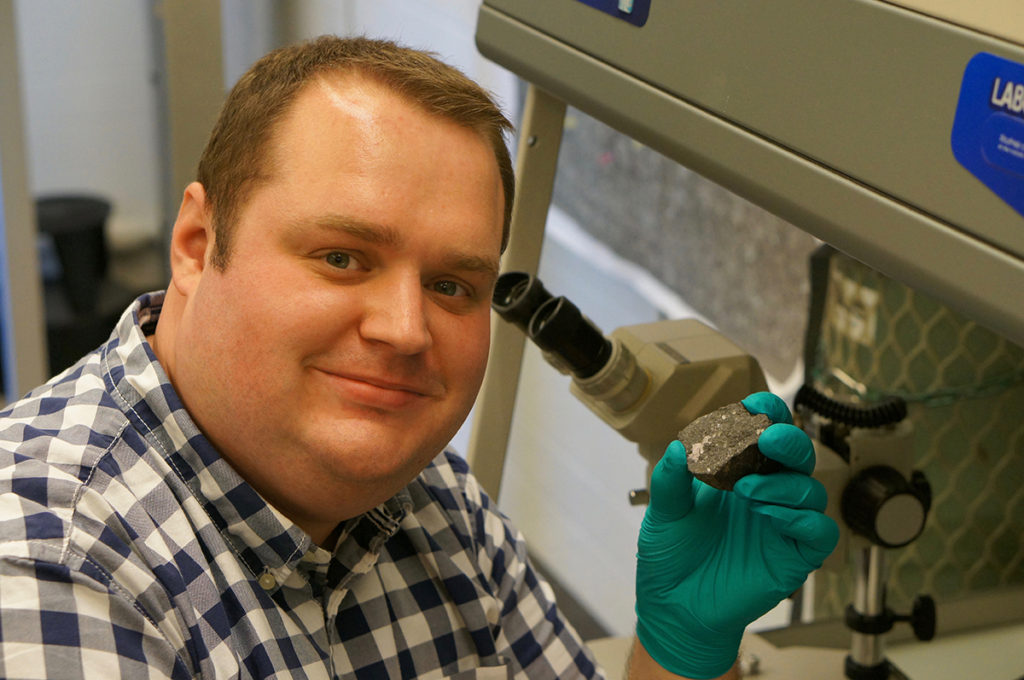Student’s cosmic discovery may shed light on the origin of our solar system

Pierre Haenecour studies presolar grains, little specks of stardust that predate our solar system and travel to Earth via meteorites. Haenecour will graduate with a PhD in Earth and Planetary Sciences. Courtesy photo.
As a boy in Belgium, Pierre Haenecour loved hunting for fossils and collecting minerals. He was fascinated both by their sheer age and the clues they revealed about a world long gone.
“It was so exciting to hold in my own hands these remnants of animals that lived millions of years ago,” Haenecour said.
Today, as a NASA Earth and Space Sciences Fellow, Haenecour hunts specks of interstellar matter from billions of years ago. Known as presolar grains, these bits of stardust predate our own solar system and travel to Earth in meteorites.
For years, Washington University researchers have studied presolar grains at the Laboratory of Space Sciences, one of the world’s leading sites for extraterrestrial material research. But in 2013, Haenecour found a new type of grain, composed of silica, a common component of sand, and enriched with oxygen-18, a rare, heavy isotope of oxygen. That could mean only one thing — the grain came from a supernova, perhaps the very supernova that, upon its explosion, triggered the formation of our solar system. The news made headlines in both scientific journals and mainstream outlets like Science and the New Yorker.
As Haenecour prepares to graduate with a doctorate in Earth and Planetary Sciences from Arts & Sciences, he reflects on his discovery, why space research matters and how he made time to serve Washington University while conducting groundbreaking research.
What was your response when you realized you had found this grain?
To be honest, we didn’t know at first that no one else had found it before. People had found silica grains from other stars but not from a supernova. We can’t tell the precise age, but we do know it formed before our solar system, over 4.6 billion years ago. That makes it one of the oldest things on Earth.
Beyond the wow factor, what also can we learn from presolar grains?
Before the planets formed, there was a large cloud of interstellar dust and gas, and a large portion of this dust was the presolar grains. While most of them were destroyed in the early stages of solar system formation, a small portion of these grains remained intact inside asteroids and comets, and can be found today in meteorites. By studying presolar grains, we can understand how dust grains form around stars and what was the nature of the original material from which our Sun and all the planets were made from. We do this using specialized equipment and techniques. One of the former professors here calls what we do “laboratory astronomy.” An astronomer can use a telescope to look at stars from far away, but we can learn about stars by looking into a microscope.
There is an ongoing debate in America about funding for space research? Why should this work be supported?
I struggle with that. People in the School of Medicine and Brown School, for example, are solving problems that are affecting people right now. What we do in comparison is much more abstract. But we, as humans, have always had this innate curiosity to explore and to know where we came from. We need the answers to those questions.
Beyond your research here, you were very active on campus, serving as co-president of the Graduate Student Senate and working closely with the Office for International Students and Scholars. Why was that work important to you?
As a world-leading research university, Washington University has a large population of graduate students that contribute to the university’s excellent research and teaching. We live on campus more than we live at home, and yet we feel very isolated in our labs and departments. Many of us also feel the university cares more about undergraduate students. I started out as the GSS representative for the Earth and Planetary Sciences graduate students and a member of the Diversity Committee the year Ferguson happened, and that got me involved in interesting discussions and student activities. As co-president of the Graduate Student Senate, I am working closely with students and administrators like Dean William Tate to make changes that will improve the overall experience for all graduate students. I am optimistic that the university will continue its efforts to better recognize and support graduate students.
As an international student, what was your response to the Ferguson protests?
We live on a small island at Washington University isolated from a lot of the issues in St. Louis. It was important for me to see Ferguson myself and what I found was a neighborhood a lot like the working class neighborhoods we have in Belgium. What really amazed me was the way people reacted to the protests. Where I grew up, we have protests and strike all the time for varied issues. They are considered an integral aspect of a democratic society. It’s normal for me to see protests. But that’s not true here, and so people were very afraid. This came as a strong shock to me.
So what’s next for you?
I will stay here for now as a postdoctoral fellow in the McDonnell Center for the Space Sciences and study interstellar organics found in micrometeorites and interplanetary dust particles. Beyond that, I am not sure. I love research, but I’m also really interested in science policy and how it can directly help impact people’s lives.
by Diane Toroian Keaggy